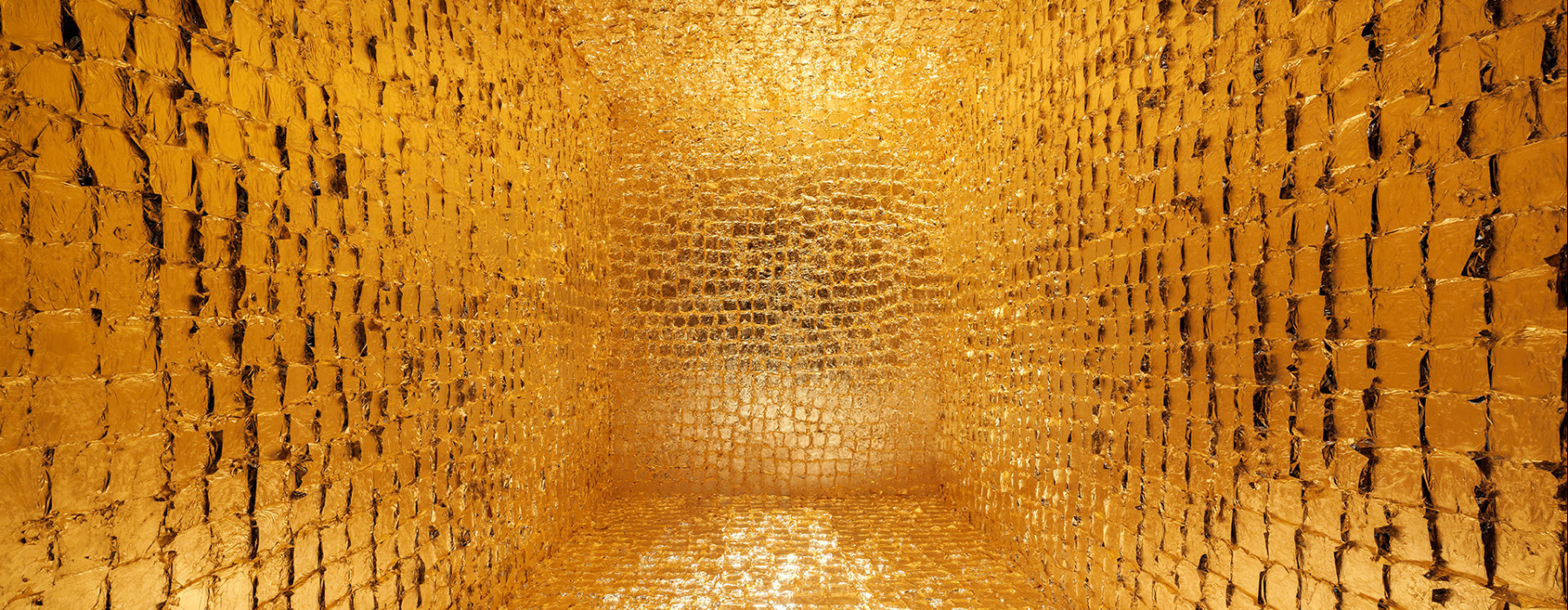
1,2. Cufflinks
Silver-gilt; Sumatra, Indonesia; before 1920; gift of the Batak Institute; TM-114-67, -69
3. Belt
Gold; Savu, Indonesia; before 1890; purchased from A.B.C. Frieser-Lans; TM-3993-2
4. Tunic, Qmaija Kebira
Silver-gilt thread, silk, cotton; Tunisia; c. 1940; acquired from I. Grammet; TM-6353-1
This tunic is part of a bride’s wedding outfit. The entire thing is so stiff that the bride could hardly move. The outfit was worn on the third day of the wedding ritual, the Jelwa day, when the bride was shown to the family, wedding contracts were exchanged and the dowry was inventoried. The bride would normally embroider the outfit herself, sometimes with the help of female relatives. A girl would spend months, sometimes even years, making her clothes for the wedding.
5. Headscarf
Gold thread; Bali, Indonesia; purchased from the Dutch Missionary Society; WM-17423
In Bali, prada is the technique of decorating fabric with gold dust or gold leaf. First, the pattern is drawn on the fabric. Then the gold leaf is applied using fish glue, or ancur. In the past, the base material would often be a Javanese batik cloth, as with this headscarf. These days, a brightly coloured cloth is often used as a base, with plastic foil or gold paint for decoration.
6. Pre-Columbian clothing ornaments
Gold; Quimbaya; Columbia; 1000-1400; purchased from Niels Halbertsma; TM-2731-6,-7
In the Pre-Columbian period (before Columbus arrived in 1492), leaders in societies in the region we now know as Colombia would wear gold objects to demonstrate their power. Such ornaments were worn on the clothes.
7. Tied headscarf, udeng
Gilded cotton thread, cotton; Bali, Indonesia; before 1950; purchased from B. IJzerdraat; TM-2030-3
This tied headscarf worn by men, udeng, is made of purple cotton with a pattern in gold, known as prada. Udeng is the traditional headdress worn by men in Bali, and is part of the outfit that must be worn during religious ceremonies. The headscarf is tied in a particular way to signal that the wearer has control of his mind and thoughts.
8. Penis cover
Gold; Java, Indonesia; 1300-1400; purchased from G. Tillmann; TM-1771-18
This plate was probably worn by an aristocratic hermit. It has an image of a woman, her arm bent, symbolising seduction and yearning. The scene refers to the poem Arjunawiwāha, in which Prince Arjuna is tempted by heavenly nymphs while meditating.
9. Six buttons for a blouse
Gold; Sumatra, Indonesia; before 1920; gift of Batak Institute; TM-114-63
10. Cufflinks
Silver-gilt; Sumatra, Indonesia; before 1920; P.A.W. Snouck Hurgronje; TM-114-65
11. Belt with tiger claws
Gold, tiger claws, silk; Sumatra, Indonesia; early 20th century; gift of P.A.W. Snouck Hurgronje; TM-1572-3
Jewellery with tiger claws was worn by the Peranakan Chinese as an amulet. They believed that wearing a tiger’s claw would protect the wearer from tigers. The gold ornaments were made by Chinese craftsmen.
12. Men’s brooches
Gold; Walcheren, the Netherlands; 1900-1926; courtesy of the Dutch Open Air Museum Arnhem
In Dutch local dress, brooches were mainly for women. But the men of Walcheren were an exception. They would wear a brooch on their shirt when dressed in their Sunday best. The brooch would be worn below the collar studs as ornamentation.
13. Jacket with gold leaf
Gold thread, cotton, natural dyes; India; before 1946; gift of F.J. Vattier Kraane-Daendels; TM-1698-358
Long before the arrival of Europeans, the islands of Indonesia were trading with India. Indian textiles, like the fabric of this jacket, were particularly popular. Aristocratic men would wear such a jacket with trousers on special occasions. The design of the jacket may have been inspired by Ottoman textiles and a Japanese kimono. The prada, gold leaf applied with glue, gives the garment a luxurious look that reflects the status of the wearer.
14. Men’s jacket
Gold thread, velvet, cotton; Pakistan; mid-20th century; purchased from E. Powell; TM-3500-56
This men’s jacket is for special occasions. The embroidery consists of braided gold thread applied to the fabric in a technique known as couching. Here, gold is a luxury detail that emphasises the man’s status.
15. Kimono
Kisaburo Nishimura; gold thread, gold foil, silk; Japan; 1996; acquired from Japan Netherlands Culture Center; WM-74434
This Japanese kimono includes gold thread and gold leaf. When the wearer walks, the fabric moves and the sun shines on the gold surfaces, creating a subtle glittering effect. The restrained colour and the shape of the sleeves indicate that this kimono is intended for a (married) woman of a certain age.
16,17. Collar studs
Gold; Zuid-Beveland, the Netherlands; 1825-1865; courtesy of the Dutch Open Air Museum Arnhem
In many regions, the collar of a man’s shirt would be fastened using a pair of collar studs. They would be attached behind with a small ring, to close the collar. The studs would be passed through the buttonhole on either side of the collar. Men wore long linen shirts both day and night, so they would wear collar studs all the time.